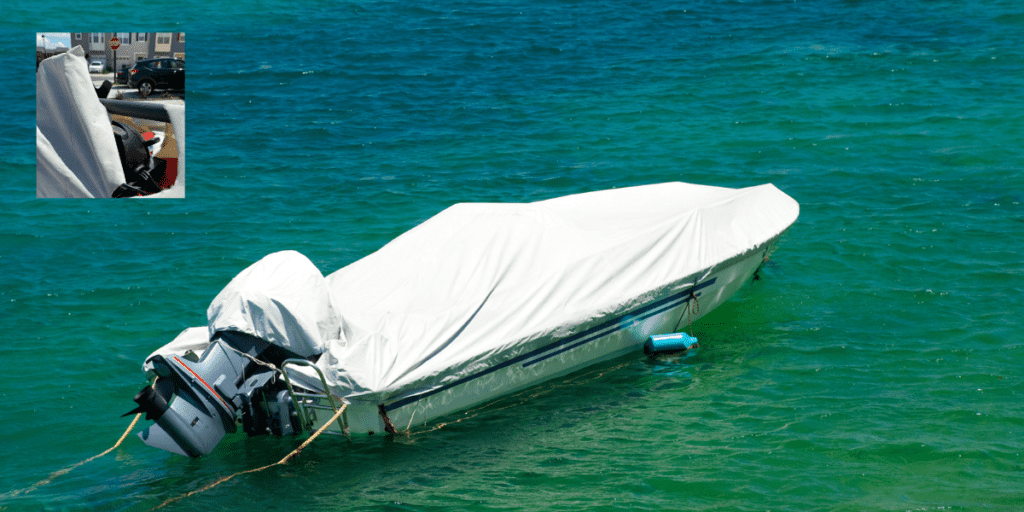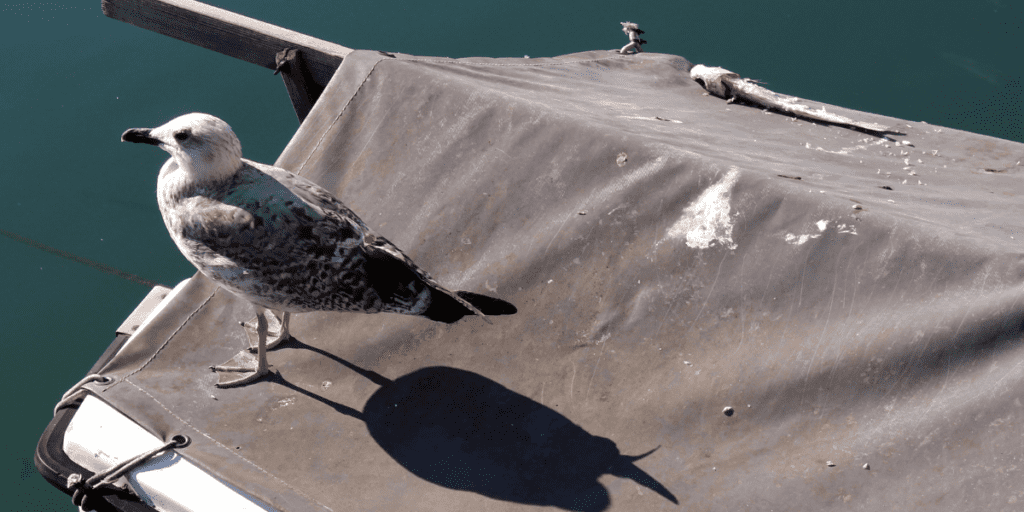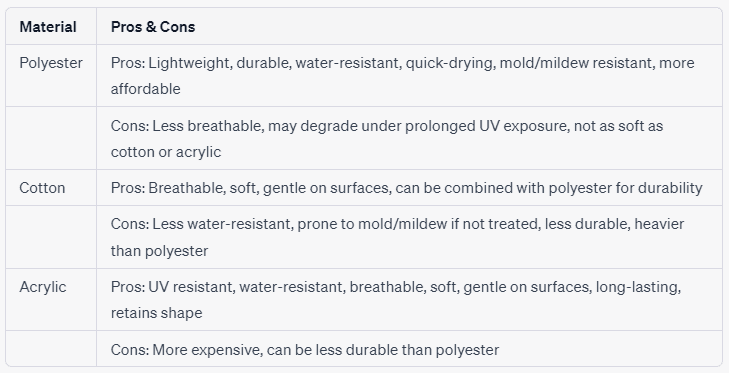Selecting the Right Boat Cover: The Essential Guide

Selecting the right boat cover is an essential aspect of boat ownership, I should know. I purchased my used bass boat a few years ago and it came with a custom cover. There was some wear on the cover, so I knew it would not last much longer but I had hoped that it would last one more season.
After our most recent heavy downpour, the area that covers my trolling motor finally gave way to dry rot. So I started my research. Did I want to invest in a custom boat cover or should I purchase a universal boat cover and save myself some money?
In this comprehensive overview, I’ll look into the nuances of picking an appropriate cover that suits your budget and needs.
I’ll discuss why having a proper boat cover is crucial in preserving resale value and deterring theft. I will explore the various factors to consider when selecting the appropriate boat cover, such as material selection, custom-fit versus semi-custom or universal fit covers, and additional features like ventilation systems and warranty support.
I’ll help you determine which type of boat cover best suits your situation – be it mooring covers for storage on water, trailering covers designed for transportation, or storage covers providing off-season protection.
I will also touch upon seasonal considerations in using boat covers during summer vs winter months as well as their importance during transportation and long-term storage.
Table of Contents
Why Use a Boat Cover

Boat covers are essential for protecting your investment, enhancing security, and maintaining cleanliness. They help preserve the boat’s resale value by preventing damage from weather, UV rays, and other environmental factors.
Additionally, they deter theft and vandalism while keeping critters out of your vessel. Using a boat cover also keeps debris, dirt, leaves, and the always-present bird droppings out of the boat which minimizes the need for frequent cleaning.
Preserve Resale Value
Your boat’s resale value can be significantly impacted by its exposure to harsh weather conditions such as rain or snowstorms as well as harmful UV rays that cause fading over time.
A high-quality boat cover acts as a shield against these elements so you can maintain your vessel in pristine condition throughout its lifespan.
Deter Theft and Critters
An uncovered boat may attract unwanted attention from potential thieves or vandals who see an easy target in plain sight.
By using a securely fitted cover, you’re sending a clear message that your property is protected – making it less likely to become an object of interest for criminals.
Beyond human threats are those pesky critters like rodents or insects that could find their way into your beloved watercraft if left unprotected. A properly fitting boat cover will help keep them at bay while ensuring no nesting materials end up inside when the boat is not in use.
Maintain Cleanliness
- Dirt & Debris: A fitted cover helps protect boats from having dirt, leaves, and other debris accumulating in your vessel. This means less time spent cleaning and more time enjoying the water.
- Mold & Mildew: A well-ventilated mildew-resistant cover allows air circulation while keeping out moisture, preventing these issues from developing.
- Bird Droppings: Birds are notorious for leaving droppings behind on boats left uncovered – a problem that can be easily avoided with the use of a proper boat cover.
In short, investing in a quality boat cover not only protects your valuable asset but also saves you time and effort when it comes to maintaining its appearance over the years.
Now let’s look into how to pick the correct cover for your boat.
Key Takeaway: Investing in a high-quality boat cover is essential for protecting your investment, deterring theft and vandalism, and keeping critters out of your vessel. It also helps preserve the boat’s resale value by preventing damage from weather, the sun’s rays, and other environmental factors while reducing maintenance efforts.
Choosing the Right Cover

Selecting an appropriate boat cover involves considering various factors such as material selection, fit and size, and additional features. By taking these aspects into account, you can ensure that your boat is well-protected from environmental elements while also looking great for many boating seasons.
Material Selection
The type of material used to make a cover plays a crucial role in its durability and protection capabilities as well as its expected useful life. Here is a table with the pros and cons of the three main types of materials used: Polyester, Cotton, or Acrylic.

In addition to choosing between different types of fabrics, it’s important to decide whether you need a waterproof or water-resistant cover based on your local climate conditions.
Waterproof covers prevent any moisture from penetrating through whereas water-resistant ones only repel some amount of moisture without providing complete protection against heavy rainfalls or submersion events like flooding.
Boat Cover Fit Types
The fit of your boat cover is another important factor to consider. There are three main types of fits:

Before selecting the right size cover for your boat, it is essential to take precise measurements. Take measurements of your boat’s length, beam width, and height before making any purchases. This will help you avoid potential issues with improper fitting.
Check out this helpful guide on how to measure your boat for a cover.
Additional Features
Beyond material selection and fit, there are additional features that can enhance the overall performance and longevity of your chosen boat cover. Some key aspects include:
- Ventilation systems: To avoid moisture buildup and mold, opt for covers with vents or buy separate vent accessories as needed.
- Strapping mechanisms: For secure transportation at high speeds, choose a cover with reliable strapping like buckles, tie downs, or cords.
- Warranty and customer support: A comprehensive warranty and responsive customer service can provide assurance for your purchase, addressing potential future issues.
Taking all these points into consideration will enable you to come to an informed decision when picking the ideal boat cover for your requirements, guaranteeing maximum security, aesthetics, and endurance.
Key Takeaway: Choosing boat covers involves considerations of material, size, fit, ventilation, and warranty. Despite their cost, custom-fit covers made from durable, UV-resistant materials like polyester and acrylic provide the best protection.
What Type of Cover Fits Your Needs?

The ideal choice depends on how you use your vessel. Assessing your specific needs will help determine the most suitable type of cover for your boat. Here I will discuss the three common types of boat covers: mooring covers, trailering covers, and covers for storage.
Mooring Boat Covers
Mooring covers are designed to protect your boat while it’s stored on the water. These boat covers provide a secure fit around the entire vessel, ensuring that it stays protected from weather elements and debris during periods when not in use.
The securing and removal process should be easy to manage so that you can quickly access your boat whenever needed. Some popular brands offering high-quality mooring covers include Carver Covers and Taylor Made Products.
Trailering Boat Covers
If you frequently transport your boat by trailer, a trailering cover may be the best option for you. These specially designed covers feature straps or other securement devices that ensure a tight fit even at highway speeds – preventing damage caused by wind resistance or road debris during transportation.
Additionally, they’re made with durable materials capable of withstanding harsh conditions encountered while traveling long distances over various terrains like highways or dirt roads alike. One reputable brand offering top-notch trailering options is Classic Accessories.
Storage Boat Covers
Last but not least, storage covers are designed to protect your boat during off-season periods when it’s not in use. These covers typically provide a relaxed fit than mooring or trailering options, allowing for proper ventilation and preventing moisture buildup that could lead to mold growth inside covered areas.
It’s essential to choose a storage cover with adequate venting systems – such as those offered by CoverQuest – ensuring the longevity of both your vessel itself and its various components throughout extended durations spent unused/unoccupied.
Understanding how you use your boat will help determine which type of cover is best suited for your needs. Whether you require protection while storing on water (mooring), transporting via trailer (trailering), or keeping safe during off-season months (storage) – there’s an ideal solution available tailored specifically towards meeting these unique requirements.
Key Takeaway: There are three common types of covers: mooring covers for storage on water, trailering covers designed for transportation, and storage covers providing off-season protection. Understanding your needs will help determine which type is best suited for you.
When to Use a Boat Cover

Knowing when to use a vessel cover is important. Proper use guarantees your boat stays ready for use throughout the boating season and is secure in the off-season. This section will discuss various scenarios in which using a boat cover is essential, including seasonal considerations, transportation, and long-term storage.
Seasonal
In the summer months, protecting your boat from UV rays and heat is crucial. A quality boat cover with UV protection can prevent fading of upholstery and other materials while also reducing interior temperatures.
During winter months, shielding your vessel from snow, ice, and freezing temperatures becomes necessary. A heavy-duty cover designed for a snug fit in cold weather conditions will help protect against potential damage caused by these elements.
Transportation
- Road debris: When transporting your boat on the highway or even local roads, it’s exposed to dirt particles kicked up by other vehicles’ tires or falling leaves that could scratch its surface or accumulate inside compartments. Using a trailering-specific cover helps keep road debris at bay during transport.
- Secure fit: Ensuring that your chosen boat cover fits securely onto your vessel is critical when traveling at high speeds on highways; otherwise, you risk losing the protective covering altogether. Look for covers with adjustable straps or securing mechanisms like buckles so they remain firmly attached during transit.
Storage
If you plan on storing your watercraft for an extended period, a boat cover is essential to prevent damage and maintain cleanliness.
- Prevent damage: Dust and moisture can accumulate over time, potentially causing mildew or mold growth on your vessel’s surfaces. A quality storage cover with proper ventilation will help protect against these issues.
- Maintain cleanliness: Keeping your boat covered during long-term storage helps maintain its overall appearance by preventing dirt, leaves, bird droppings, and other debris from accumulating both inside and outside the watercraft.
In each of these scenarios – seasonal protection, transportation security, or long-term storage care – choosing the right boat cover plays a vital role in preserving your investment while also ensuring it remains clean and ready for use whenever you’re ready to hit the water again.
Key Takeaway: Using a boat cover is essential to shield your vessel from seasonal weather, road debris during transit, and damage during storage. UV-protective covers can prevent upholstery fading in summer, while heavy-duty options are designed to safeguard against winter conditions. A secure fit is crucial during transport to maintain the cover’s effectiveness and prevent dirt buildup in the watercraft.
Wrapping It All Up
Choosing the right boat cover is crucial for protecting your investment from environmental factors, theft, and critters. By selecting the appropriate material and fit for your boat, you can preserve resale value, reduce maintenance efforts, and ensure long-term protection. By doing your research and considering your specific needs, you can find a boat cover that will provide the protection your boat needs to stay in top condition for years to come.
FAQs
What Type of Boat Cover Is Best?
The type of boat cover you need depends on your usage and storage requirements. Mooring covers are ideal for storing boats on the water, trailering covers protect during transportation, and storage covers provide off-season protection. Consider seasonal needs and desired features like ventilation systems, water resistance, and warranty support.
How Do I Choose the Right Size?
To choose the right boat cover size, measure your boat’s length overall (LOA) from bow to stern, including any extensions such as swim platforms or motor brackets. Also, consider the beam width at its widest point. Use these dimensions to find a custom-fit, semi-custom fit, or universal cover that matches your measurements.
What Is the Best Thickness for a Boat Cover?
The ideal boat cover thickness depends on durability requirements and weather conditions. Thicker covers provide more protection but are heavier. Common materials include polyester, acrylic-coated polyester, and marine-grade canvas, with strength indicated by denier ratings.
What Is the Importance of Boat Covers?
- Boat covers protect against sun, rain, snow, dust, and debris.
- They deter theft and ward off critters.
- Covers maintain cleanliness, reducing maintenance.
- Ensure secure transportation when trailering.
- They offer ventilated storage, preventing mold growth.
